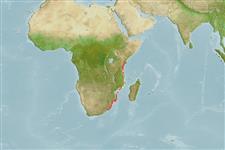Elasmobranchii (sharks and rays) >
Rhinopristiformes (Shovelnose rays) >
Rhinobatidae (Guitarfishes)
Etymology: Rhinobatos: Greek, rhinos = nose + Greek, batis, -idos = a ray (Raja sp.) (Ref. 45335).
More on author: Norman.
Environment: milieu / climate zone / depth range / distribution range
Ecology
Marine; demersal; depth range 75 - 253 m (Ref. 11228). Deep-water; 2°S - 31°S, 30°E - 43°E (Ref. 114953)
Western Indian Ocean: Kenya to Natal, South Africa.
Size / Weight / Age
Maturity: Lm ? range ? - ? cm
Max length : 127 cm TL male/unsexed; (Ref. 3919)
Short description
Identification keys | Morphology | Morphometrics
A guitarfish with a narrow, sharply pointed snout and a narrow pectoral disc; nasal flaps extend only to the inner nostril edges (Ref. 5578). Plain olive-green above, without spots; prominent black blotch on underside of snout (Ref. 5578).
A rare and unknown species found offshore on the shelf (Ref. 5578). Ovoviviparous (Ref. 50449). Taken as bycatch of trawl and gillnet fisheries (Ref. 114953).
Life cycle and mating behavior
Maturities | Reproduction | Spawnings | Egg(s) | Fecundities | Larvae
Exhibit ovoviparity (aplacental viviparity), with embryos feeding initially on yolk, then receiving additional nourishment from the mother by indirect absorption of uterine fluid enriched with mucus, fat or protein through specialised structures (Ref. 50449).
Compagno, L.J.V., 1986. Rhinobatidae. p. 128-131. In M.M. Smith and P.C. Heemstra (eds.) Smiths' sea fishes. Springer-Verlag, Berlin. (Ref. 3919)
IUCN Red List Status (Ref. 130435)
Threat to humans
Harmless
Human uses
Fisheries: of no interest
Tools
Special reports
Download XML
Internet sources
Estimates based on models
Preferred temperature (Ref.
123201): 18 - 22.3, mean 19.8 °C (based on 23 cells).
Phylogenetic diversity index (Ref.
82804): PD
50 = 0.5000 [Uniqueness, from 0.5 = low to 2.0 = high].
Bayesian length-weight: a=0.00295 (0.00151 - 0.00578), b=3.13 (2.96 - 3.30), in cm total length, based on LWR estimates for this (Sub)family-body shape (Ref.
93245).
Trophic level (Ref.
69278): 3.8 ±0.4 se; based on size and trophs of closest relatives
Resilience (Ref.
120179): Low, minimum population doubling time 4.5 - 14 years (Fec assumed to be <100).
Fishing Vulnerability (Ref.
59153): Very high vulnerability (76 of 100).
